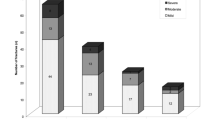Abstract
Vertebral fractures are the hallmark of osteoporosis, responsible for increased morbidity and mortality in post-menopausal women. However, two-thirds of vertebral fractures do not come to clinical attention. The aim of this study was to compare the identification of vertebral fractures on spine X-rays among rheumatologists. Study subjects were women aged 60–80 years having potential signs of vertebral fracture and visiting a rheumatologist. X-rays were performed according to standardized procedures. In 629 patients (among 824 included) at least one vertebral fracture was diagnosed, and the X-rays were then sent to a central facility where a semi-quantitative assessment of vertebral fracture was performed by a single rheumatologist trained for this evaluation. According to the vertebral level, kappa scores were between 0.20 to 0.77, i.e., below 0.6 from T4 to T7, and between 0.6 and 0.77 from T8 to L4. The false-negative fractures rate was 25.8% (and 15.7% of them were related to a numbering discrepancy). The rate of false positive fractures was 6.3%. At the patient level 6.8% had actually no fracture. This study shows that 25% of overall vertebral fractures are not diagnosed among patients considered as having at least one fracture. As a consequence, patients who require treatment to reduce fracture risk are not being properly identified.


Similar content being viewed by others
References
Eastell R, Cedel SL, Wahner HW, Riggs BL, Melton LJ 3rd (1991) Classification of vertebral fractures. J Bone Miner Res 6:207–215
O’Neill TW, Felsenberg D, Varlow J, Cooper C, Kanis JA, Silman AJ (1996) The prevalence of vertebral deformity in European men and women: the European Vertebral Osteoporosis Study. J Bone Miner Res 11:1010–1018
Klotzbuecher CM, Ross PD, Landsman PB, Abbott TA 3rd, Berger M (2000) Patients with prior fractures have an increased risk of future fractures: a summary of the literature and statistical synthesis. J Bone Miner Res 15:721–739
Kotowicz MA, Melton LJ, Cooper C, Atkinson EJ, O’Fallon WM, Riggs BL (1994) Risk of hip fracture in women with vertebral fracture. J Bone Miner Res 9:599–605
Nevitt MC, Ettinger B, Black DM, Stone K, Jamal SA, Ensrud K, Segal M, Genant HK, Cummings SR (1998) The association of radiographically detected vertebral fractures with back pain and function: a prospective study. Ann Intern Med 128:793–800
Kanis JA, Minne HW, Meunier PJ, Ziegler R, Allender E (1992) Quality of life and vertebral osteoporosis. Osteoporos Int 2:161–163
Oleksik A, Lips P, Dawson A, Minshall ME, Shen W, Cooper C, Kanis J (2000) Health related quality of life in post menopausal women with low BMD with or without prevalent vertebral fractures. J Bone Miner Res 15:1384–1392
Cockerill W, Lunt M, Silman AJ, Cooper C, Lips P, Bhalla AK et al (2004) Health-related quality of life and radiographic vertebral fracture. Osteoporos Int 15:113–119
Huang C, Ross PD, Washnich RD (1996). Vertebral fracture and other predictors of physical impairment and health care utilization. Arch Intern Med 156:2469–2475
Ensrud KE, Thompson DE, Cauley JA, Nevitt MC, Kado DM, Hochberg MC, Santora AC 2nd, Black DM (2000). Prevalent vertebral deformities predict mortality and hopsitalization in older women with low bone mass. J Am Geriatr Soc 48:241–249
Cauley JA, Thompson DE, Ensrud KC et al (2000) Risk of mortality following clinical fractures. Osteoporos Int 11:556–561
Ross PD, Genant HK, Davis JW, Miller PD, Wasnich RD (1993) Predicting vertebral fractures incidence from prevalent fractures and bone density among non-black, osteoporotic women. Osteoporos Int 3:120–126
Gehlbach SH, Bigelow C, Heimisdottir M, May S, Walker M, Kirkwood JR (2000) Recognition of vertebral fracture in a clinical setting. Osteoporos Int 11:577–582
Kim N (2004) Underreporting of vertebral fractures on routine chest radiography. Am J Roentgen 182:297–300
Genant HK, Wu CY, van Kuijk C, Nevitt MC (1993) Vertebral fracture assessment using a semiquantitative technique. J Bone Miner Res 8:1137–1148
Lindsay R, Silverman SL, Cooper C, Hanley DA, Barton I, Broy SB et al (2001) Risk of new vertebral fracture in the year following a fracture. JAMA 285:320–323
Kado DM, Browner WS, Palermo L et al (1999) Vertebral fractures and mortality in older women. A prospective study. Arch Intern Med 159:1215–1220
Delmas PD, Genant HK, Crans GG, Stock JL, Wong M, Siris E et al (2003) Severity of prevalent vertebral fractures and the risk of subsequent vertebral and non vertebral fractures: results from the MORE trial. Bone 33:522–532
Torgeson DJ, Sykes D, Puffer S, Brown P, Cooper C (2004) Pharmaceutical treatment of symptomatic vertebral fractures in primary care. Ann Rheum Dis 63:853–856
Author information
Authors and Affiliations
Corresponding author
Rights and permissions
About this article
Cite this article
Fechtenbaum, J., Cropet, C., Kolta, S. et al. Reporting of vertebral fractures on spine X-rays. Osteoporos Int 16, 1823–1826 (2005). https://doi.org/10.1007/s00198-005-1939-8
Received:
Accepted:
Published:
Issue Date:
DOI: https://doi.org/10.1007/s00198-005-1939-8




